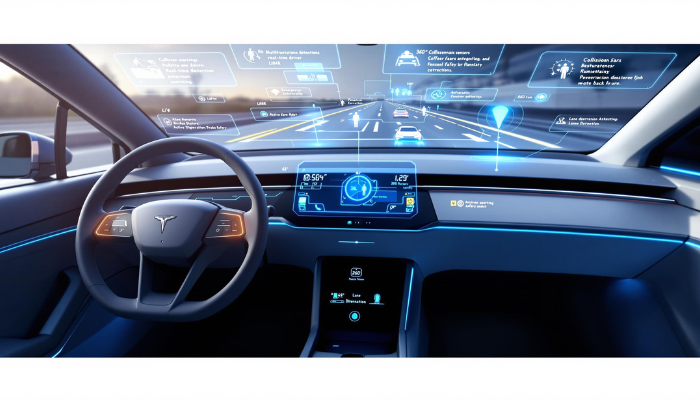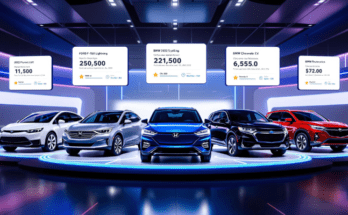Introduction
The automotive industry has witnessed rapid growth in the recent past due to ongoing technological development in the various automobile inventions implemented to enhance safer, efficient and comfortable driving. Autos have been designed with safety in mind from the word go, especially with the improvements in technology, safer and more sophisticated systems from the automotive industry are still expected. According to the stat, it is imperative to analyse the budding changes in car safety that may alter how the car owners drive by the time we get to 2025 making the roads safe for everyone.
Adaptive Cruise Control (ACC)
Among the best car safety features for 2025, one will find that ACC or Adaptive Cruise Control is one of the most important ones. This technology is basically the traditional cruise control technology enhanced by radar and sensors that enables the car regulate its own speed according to traffic density around it. Besides, ACC is not only useful to prevent a car from over-reaching the distance with the car in front but also useful when entering ramps or rejoins traffic stream. This advanced system eradicate driver fatigue and rear collision since it replaces human in the cabin by sensing the environment and responding to the traffic conditions.
Advanced Emergency Braking system (RTA stands for Risk of Threats Analysis)
One of the vital car safety systems that analysts believe will come under the spotlight in the next five years is the Advanced Emergency Braking (AEB). By combining radar, cameras and advanced machine learning algorithms, AEB makes sure those follow through collisions happen, and applies the brakes to prevent it. One of the most important factors for future mobility is AEB, as it can play a preventive or at least limit the risk of an accident premising.
Surround View Cameras and 360 Degree Parking Sensor
As self-driving and partial self-driving systems become more common, one of the issues that arise is parking into confined areas. By 2025, car manufacturers will integrate the best Surround View Cameras system and 360-degree Parking Sensors to solve this problem. They offer complete information about the environment of the car so they can move easily within the congested areas and even park successfully even in the most congested areas.
features including an advanced Active Lane Assist and Blind Spot Monitoring
Accidents in roads are mostly caused by failure to keep within lanes and sudden changeovers. By the year 2025, car safety features will shift towards improving the actively named Active Lane Assist and Blind Spot Monitoring to help avoid such risks. Active Lane Assist employs cameras and sensors to identify the outlines of the lanes and the driver’s commands concerning the steering wheel and then steers the car back into the lane if it determines the driver was drifting inadvertently out of the lane. In contrast to Blind Spot Monitoring, which uses radar sensors to monitor whether other vehicles are in the driver’s blind spots and warn the driver by using visual, audible and vibrational signals if a collision occurs, Launched is monitored by a camera mounted on the rear-view mirror.
As a crash avoidance system, Autonomous Emergency Braking (AEB)
AEB stands for Advanced Emergency Braking and is a precursor to a more recently developed system called Autonomous Emergency Braking. In 2025, AEB in addition to warning the driver about an objective probably collision, will actively steer the vehicle to avoid an accident. Applications are clear for this state-of-art technology, and especially for cases when drivers might be briefly distracted or cannot respond timely; roads will be safer across the world.
However, the primary application of V2X today is Vehicle-to-Everything (V2X) communication
V2X Communication is one of the most promising innovations in car safety features for 2025. This technology enables cars to exchange signals between themselves as well as with surrounding roads and traffic signals, other signals and pedestrians and other roadway users thereby making roads safer and free from congesting. V2X communication shall assist in the fight against the occurrence of accidents especially through the prompt transfer of real-time information on the road and traffic characteristics, adjustment to prevailing circumstances and the right management and organization of the traffic to enhance the flow of the traffic for ease of journey.
Conclusion
Considering where the technology and innovations of today are leading people to the future of car safety features looks promising. Hoping that by the year 2025 the following technical features will be implemented and released to the market among which we will find Adaptive Cruise Control, Advanced Emergency Brake Control, Surround View Cameras and 360-degree Parking Sensors, Autonomous Emergency Braking Systems, all of that helping to reduce risks connected with the human factor and making roads safer. Furthermore, with the V2X communication technology it is possible to see an even more sophisticated system of transport interactions that will meet the needs of drivers and guarantee a Safe, Efficient, and Sustainable environment for everyone. Car safety in the future is future is now and it is going to make driving an entirely different experience.




